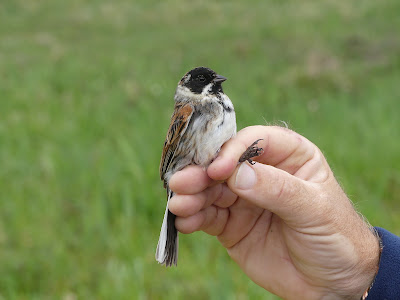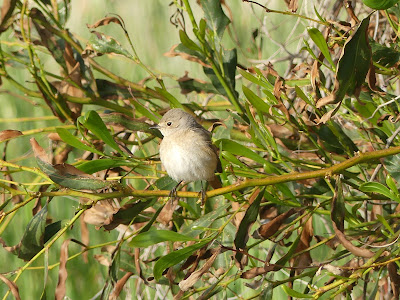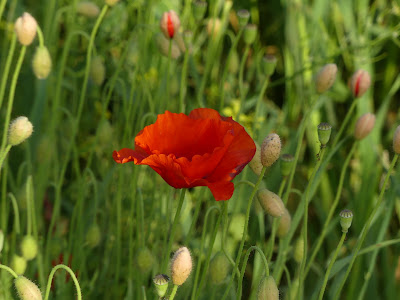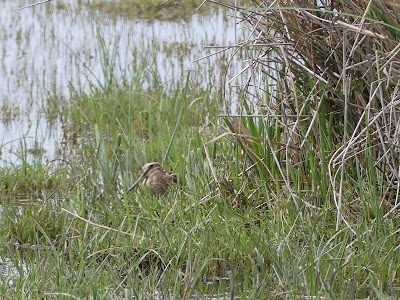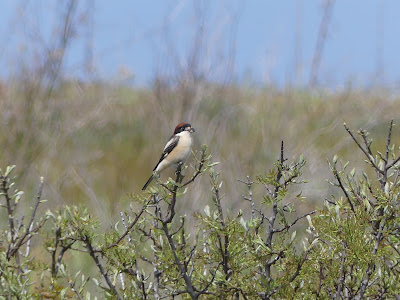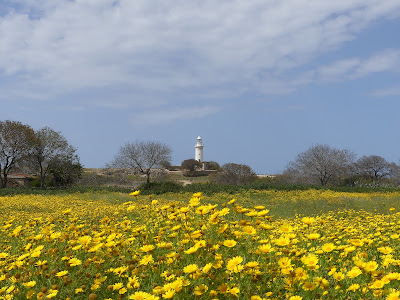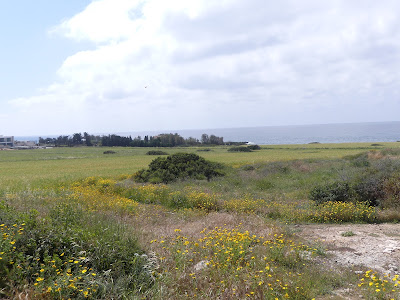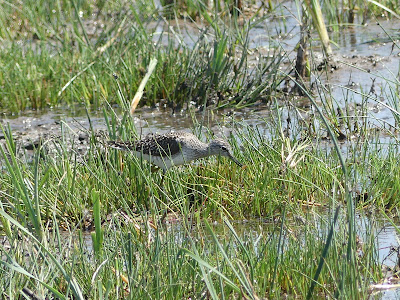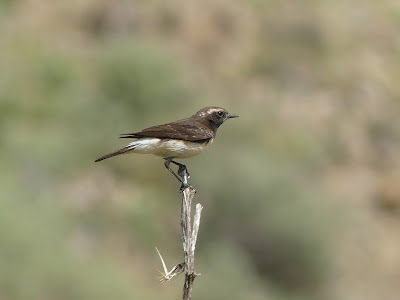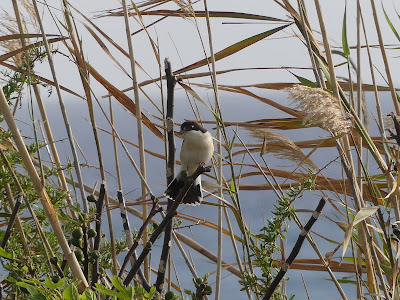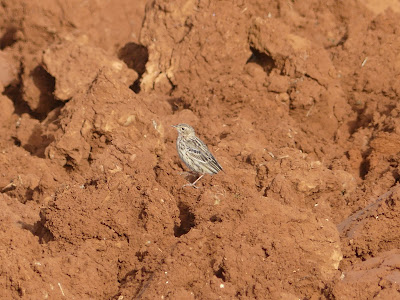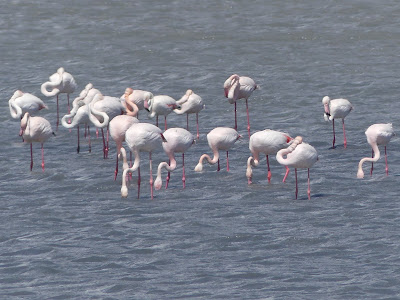So we finally got the Cyprus visit originally planned for 2020! We arrived in Larnaca quite late on the 21st, stayed at the Lebay Beach Hotel ( very good).
Day 1
We were out just after 6am for a look at Oroklini before breakfast, the water level was high and the mosquitos were out in abundance. The Flamingos were wading in deep water, no chance of seeing any colour rings. The lake held the usual collection of waterfowl including Ferruginous Duck, Gargany, Shoveler, Teal, Gadwall, Pintail, Red crested Pochard and also a Widgeon.
Passerines in the Tamarisks surrounding the water included several Chiffchaff, Lesser Whitethroat, Cetti's Warbler and Bluethroat.
Bluethroat, red-spotted form
At Larnaca Salt Lake the water level did not deter 6 Gull-billed Tern, 2 Avocet, Spur-winged Plovers, Black-winged Stilts, some shanks both Red and Green, Ruff, Marsh Sandpiper amongst others. We saw Laughing Dove for the second time that day and noted that these birds have colonised sites some distance from the handful where they could be found in 2019.
With the Tekke of Hala Sultan in the background we watched Slender-billed Gulls pick mosquito larvae from the surface of the lake.
Some Slender-billed Gulls looked a bit scruffy in main body moult,
but this one's quite smart with a hint of a pink hue on the throat and chest.
Then on to the sewage works where there were no Black-necked Grebes at all. A flock of wagtails consisted of mainly Black-headed Yellow Wagtails, but there were some others too, including a Citrine Wagtail.
Record shot, Citrine Wagtail
Amongst the expected gulls also Little and Mediterranean, with Lesser Whitethroat and Ruppell's Warbler in the bushes. Moving on towards the sewage works Hoopoe and Wryneck were both seen. Then when checking the beach for Kentish Plover we also found a Greater Sand Plover. There were obviously quite a few arrivals that evening as there was even a Blue Rock Thrush on the wall around the army camp.
It was then time to head west towards Mandria where we would base for the majority of the trip. As we drove, reports of a Black-bellied Sandgrouse came through on Whatsapp.
Day 2
Up at 6:15am and out before 7am we decided to take a tour around Mandria to see which fields looked to hold birds and to refamiliarize ourselves with the tracks (some might no longer be passable and we do not have much clearance with the hire car). Met Gary Elton and Colin Richardson looking for the sandgrouse that had been reported as being flushed from the sandpit by dog walkers earlier. We all decided to scout the surrounding fields so split up and not long afterwards a message came through and the bird was relocated about two minutes away from where we were watching Redstart, White Wagtails and Water Pipit.
Black-bellied Sandgrouse, Mandria fields
A quick stop for a breakfast croissant and coffee and off to Ayia Varvara to check out the state of the tanks. There was plenty of water although tracks were less passable than our last visit and we walked around looking for damsel and dragonflies as well as birds.
Sea Lavender
Crown Daisies
Winter Damselfly (the only damselfly
to overwinter in its adult form)
One of three Tree Pipits that passed through
Spotted Crake
Lesser Emperor pair
Then on to Anarita. We were disappointed to see that there are areas being cleared for housing development or businesses with new preparation for more roads, while the existing tracks were the worse for wear in some places.
Female Stonechat
Wryneck
Black-eared Wheatear
Pafos Blue, Anarita
Eastern Dappled White, Anarita
Wild Garlic
Irises, only some 20cm tall
Anemone
Then back to Mandria for the end of the day. Wheatears were arriving, being seen in the sandpit at first then on the ploughed fields. There were also Chiffchaffs, Redstarts, a Black Francolin and a Black Redstart that I couldn't photograph due to an awkward wheatear that we decided eventually was Cyprus Pied Wheatear.
Male Northern Wheatear (1st year from the brown feathers
in the wings)
Northern male
Female Redstart
Male Redstart
Field Poppy
Cyprus Pied Wheatear
Day 3
A trip over to Limassol for Zakaki, Ladies mile and the gravel pits. First stop was spectacularly disappointing with a fence erected along the water's edge where we have seen Bluethroat, Mustached Warbler and many other birds. Now I guess you just have to look at the pictures. The casino in the background is no enhancement to the view either and the cleared viewing area is just too sterile. Saw Woodpigeon, Snipe, Coot, Moorhen and Reed Warbler. The signage says this is now Lake Makri, a makeover that is not an improvement.
Next on to Ladies Mile where there seemed to be some attempts at blocking some of the tracks across to the mast area. The only birds on the water were Little Stint, Kentish Plover and Little Egret.
Crossing the bay Bishop's Pool would have been the next stop, but it is now locked - something that must have happened in the four years since our last visit. It used to be great for migrating herons and egrets, also Ferruginous Ducks. What a shame.
We needed a coffee after all that disappointment, really not worth coming to these areas again, so on to Phassouri where the area was surrounded with scaffolding poles about 6 years ago. The high water levels have worked wonders on the grassy areas, looks very promising.
View from the tower hide
Seen from the road were
Snipe
Spur-winged Plover
Glossy Ibis
Great White Egret
Waterrail
Hoopoe
It's a shame they didn't use a couple of those fence panels at
Zakaki here instead.
White-faced Wagtail Dukhunensis
Water Pipit - one of six
Also Great Spotted Cuckoo, Marsh Harrier, Citrine Wagtail, Yellow Wagtails, Wood Sandpiper, Black-tailed Godwit, Spoonbill, Ruff and Cattle Egret.
Well that was an improvement on the day so next to the gravel pits.
Agios Georgios
The garden provided shelter as the wind got up and birds seen included Eastern Bonelli's Warbler, Lesser Whitethroat, Redstart, Greenfinch and a Collared Flycatcher.
Eastern Bonelli's Warbler
Female Ruppell's Warbler
We'd seen well into double figures of this species by the end of the day, also more Hoopoes and plenty of Wheatears of various species as the end of the day neared.
Eastern Black-eared Wheatear
Eastern Stonechat
Day 4
Today we joined up with Gary Elton. Starting at Pafos headland, we spent three and a half hours there and saw a constant stream of migrant birds. Highlights were Masked Shrike (3), Woodchat Shrike (3),Hoopoe (12 including a group of 6), Tawny Pipit, Black Redstart (2) Stone Curlew (3), Purple Heron, Redstart, Eastern Black-eared Wheatear, Northern Wheatear, Cyprus Wheatear, Eastern Subalpine Warbler, Corn Bunting, Ruppell's Warbler, Lesser Whitethroat, Whitethroat, Great Spotted Cuckoo.
Record shot Tawny Pipit
Kourkoutas
Woodchat Shrike
Crown Daisies and lighthouse
The next stop was Ayia Varvara. A look around the tanks turned up a new species for the trip, and the calling Little Owl gave away its chosen hide out. We also got another look at the Spotted Crake.
Field Poppy
Jack Snipe
Marsh Frog
We finished the day off with a last look at Mandria. Here there were wagtails and wheatears dropping in as was expected. We also found the Collared Pratincole that has been reported from the morning.
Record shot Collared Pratincole
A quiet corner of the site turned up Ruppell's Warbler, Eastern Subalpine Warbler, Blackcap and Chiffchaff next to a citrus grove, while the weedy margins around some fields threw up another interesting Stonechat.
Siberian Stonechat
Then, for good measure, we finished up with the Black-bellied Sandgrouse again, feeding happily and unbothered by we few birders watching from a respectful distance.
Black-bellied Sandgrouse
Day 5
We started in the direction of Cape Dreparnum, stopping at Dam Mavrokolymbus on the way. There were good species to be seen with 5 Cyprus Warbler, Bonelli's Eagle and Little Owl the highlights.
A Little Owl to kick off the walk at the dam.
Pafos Blue male
Bonelli's Eagle
Cyprus Warbler
A nice walk at Cape Dreparum, Mediterranean Shag seen on the island, also a Cretzschmar's Bunting.
Pygmy Skipper
Record shot Cretzschmar's Bunting
Then on to Anarita Park in the hopes of finding Spectacled Warbler. We didn't but there were other birds to see.
Corn Bunting
Little Owl staying close to home.
We ended the day at Ayia Varvara where we tried the tanks and found Citrine Wagtail, Baillon's Crake, Little Crake, Little Egret, a few waders and hirundines including Red-rumped Swallow and our first Sand Martin.
Little Ringed Plover
Little Egret
3rd and closest Citrine Wagtail of the trip
Baillon's Crake
Day 6
Just Chris and me again and we started at Kensington Cliffs. We couldn't find any birds on the cliffs, from either our usual stop or the new viewing hide.
The location of the new hide is a long way from where the Griffon Vultures
nest and roost. It's a beautiful spot with long drops that deserve the utmost respect.
Unusual design for vulture watching. Just watch your head.
We only saw one bird, already aloft and gaining height rapidly, so no photos unfortunately.
The next stop was a new one to us, the M1 pools. The name is a joke, a road was constructed by the Brits to connect Episkopi garrison and RAF Akrotiri and avoiding the town in between. These are tanks, disused for a long while, that are filled in order to conserve water from running straight to the sea to encourage filtration to the massive underground aquifer that is located beneath, are now in use and looking good for waterbirds.
A large flock of Egrets were feasting on the many Red-veined Darters
that have hatched from the pools.
Many Red-veined Darters are snapped up before attaining adult
colours, but here is a mature adult male.
M1 pools
Lesser Fiery Copper
On then to Akrotiri Marsh. The species present had not changed a great deal since our last visit. Indeed, there were still (probably the same) two Spoonbill and two Black-tailed Godwit and Wood Sandpipers with all the usual ducks, however the Glossy Ibis numbers had definitely increased as had the Ruff. A Spotted Redshank had not been seen on the 24th.
Spotted Redshank
Wood Sandpiper
Moving on to the gravel pits it was extremely quiet, only a few migrants were seen.
Zitting Cisticola
Orchids of the Serapias family
Even the Agios Georgios held little in the garden. Two Redstart and 5 Greenfinch were seen with a couple of Ruppell's Warblers in nearby bushes and 5 Great White Egret overhead.
Male Redstart
Agios Georgios, a Limassol stone built basilica of the 16th century
Lantana flower
Great Spotted Cuckoo, one of two seen as we left the gravel pits.
Day 7
There was a generally quiet sense to the day today. We revisited Ayia Varvara for another look at the crakes.
Baillon's and Little crake, female Ayia Varvara
The Citrine Wagtail was still there and with better light
my photo is better than before.
Next we shot inland to Episkopi hoping to see whether Siskin were still about at the picnic site.
Almonds in the environmental centre garden
A walk down to the river didn't turn up many birds, but there were some interesting insects.
Agios Ilarion
Lang's short-tailed Blue
Winter Damselfly male
Then the picnic site had no birds other than Jackdaws, but there were Eastern Festoons.
Eastern Festoon
Then on to Anarita, still quiet with a few wheatears drifting in and still no sign of the Spectacled Warblers.
Eastern Black-eared Wheatear
Isabelline Wheatear
Eastern Black-eared Wheatear - a bird with various plumage morphs
Finishing off, after dinner at Mandria. We found two pairs of Stone Curlew on the fields and a couple of Short-toed Larks on the ploughed field with some wheatears at the end of the day. Other than Swallows and White Wagtails it was very sedate, although we did reconnect with this bird that seems so relaxed now that it walked right passed the car.
Black-bellied Sandgrouse, still at Mandria
Looking westwards this evening
Day 8
Strong winds today made birding difficult. Maximum strength of 53km per hour. We started at the M1 pools where the hirundines were dashing about at speed and the wagtails and a few waders were keeping low.
Wagtails
Watching, despite the wind
There was a brief shower just before we departed for Bishop's Pool, but the wind was too strong from the west to leave any hope that the rain might force birds down. At the pool there is a new system that involves parking at the monastery, called St Nicholas of the cats. Here there is a cat food dispenser.
But we had come to see the pool, extremely full and with just Coots, Moorhen, Mallard, Little Grebe and two Ferruginous Duck on the very far side of the pool.
Bishop's Pool
Flowering Acacia tree at the water's edge
Akrotiri was next on the agenda, the church garden holding just a Collared Flycatcher, Redstart with anything else keeping low and out of the gale. We spent some time at the beach where the sea was very rough indeed.
The rough conditions kept most bird activity at bay. We did find 6 Baltic Gulls on the beach, and a distant bird may have been an Arctic Skua claimed earlier in the morning but it was too
distant for us to call.
The wreck just along the coast took a hammering.
So then we drove through the gravel pits and saw practically nothing. At the rabbit hutch pools some Ruff were present, but the marsh itself had nothing new since our last visit.
Ruff
Last of all we dropped in at Asprokremnos forest where there has been a report of a semi-collared Flycatcher. It was difficult to see in the windy conditions but eventually we saw enough to confirm the ID, but no chance of a photo. Gary' arrived with his group and some lucky clients got a brief glimpse.
Day 9
Another windy day. Although the wind was less strong than the day before it still made birding difficult. We started at the headland and found most small birds were sheltering on the leeward side of vegetation.
Spur-winged Plover was the only bird seen in the open ruins.
We don't recall ever having seen one here in the past.
Lesser Whitethroat
Male Ruppell's Warbler
Some warblers made use of the thick green bushes that provided some respite from the wind. An Eastern Subalpine Warbler was seen but not photographed.
Male and female Cretzschmar's Buntings, 2 of 5 seen
Two Tawny Pipit dropped in but left shortly afterwards. There were four Hoopoe foraging around the pathed areas.
Hoopoe
One of the Hooded Crows had a beak deformity.
The deformity doesn't seem to affect ability to feed.
The standard beak shape.
Fledged Sardinian young
Vagrant Emperor
There was barely a wheatear to be found and no shrikes at all. However, there was a Collared Flycatcher and a Wryneck over to the left hand side of the site, close to the fence newly replaced and near the bus station.
After that we took a drive to Achelia where we have ringed in the past. It is all very different now with extremely thick beds of reeds and no route for vehicles along the beach.
The sea was still choppy.
Timi is a lot dryer now so we took a turn around the whole side. Still no birds, except a Stone Curlew. There was also a rapidly vanishing Black Whipsnake.
The beach shelter is designed more for heat or rain than wind.
A final turn around Agia Varvara found the tanks much fuller with water. The Citrine Wagtail had been moved off but we relocated it in a ploughed field next to where some flower pots had been emptied. Also in the field were some Lesser Short-toed Larks and White Wagtails. A Semi-collared Flycatcher was found just before we reached the last set of tanks.

Semi-collared Flycatcher
The orchard where we found it also had Wryneck, Cretzschmar's Bunting and Great Spotted Cuckoo. Hirundine numbers were up with several Red-rumped Swallows as well as swifts, swallows and House martins.
Day 10
We started off at the headland, took some time out to look at past ringing sites (both totally unworkable now), scouted Mandria and Anarita. The only new bird for the trip was Pallid Swift at Paphos headland.
Sardinian Warbler
Nightingale
Eastern Subalpine Warbler
Field poppies, Sea lavender and Crown daisies
Eastern Orphean Warbler located by subsong
My nature art and the glistening sea at Kouklia
Little Owl, Anarita
Day 11
A break from the routine today. We haven't seen Finsch's Wheatear this trip, and there are reports of one still being at Cape Greko, also not one but two rarities at at Paralimni. Having rejected a trip there for Didric Cuckoo a female Menetries Warbler is confirmed at the same site. So, on the balance of probabilities we should get something for the long trip.
We started at Greko where the number of migrants in the bushes was a nice change. We heard Thrush Nightingale, had three Blue Rock Thrush and Ruppell's, Eastern Subalpine Warbler and Spectacled and Cyprus Warblers.
Two Cyprus Warbler males agitated about something they don't want in their bush.
Male Finsch's Wheatear
Eastern Subalpine Warbler
Spectacled Warbler
Male Blue Rock Thrush
The cape is beautiful with the azure water and limestone rocky shore.
Remains of ancient inhabitants of the underwater world are in evidence in some spots.
A natural bridge
There is a selection of wildflowers, some familiar and others less so.
Laughing Dove, a story of successful colonisation - such a difference from our trip in 2019.
Now they are found almost everywhere. Sam Jones , ex ringing trainee of the group we trained
with is completing a PhD at Nicosia - he has heard that hunters have been releasing these doves
as a quarry species.
Then a look at the lake, mostly Black-winged Stilts, Coots, Ducks and Flamingos then on to the shabby half built housing estate for the two rarities. Chris and I were two of only three people to see the Menetries Warbler and after much waiting and looking we also saw the Didric Cuckoo, but neither stayed long enough to be photographed.
Day 12
Still no obvious influx of migrants so started the day at Pafos headland. Most of the birds present were unexceptional. We did however, happen across a group of people watching the Yellow-browed Warbler, saw the bird and also heard it. It didn't match Yellow-browed and for us was more consistent with Hume's leaf Warbler. We have seen, heard and indeed handled many of this species in Mongolia. We will await the decision of the committee in Cyprus.
This bird called like a Humes and for us was not correct for Yellow-browed Warbler but the decision may not concur with our thoughts.
Black Redstart
Ruppell's Warbler
Lesser Whitethroat
Swallowtail Butterfly
White Wagtail
The afternoon was spent at Mavrokolymbos dam, devoid of birds except some Cyprus Wheatears and a Blue Rock Thrush seen as we left.
A quick run to Asprokremnos dam and we were able to relocate the Red-backed Shrike that had been reported earlier.
Red-backed Shrike, a young male
Day 13
A run to Akrotiri with the wind turning easterly. M1 pools held lots of egrets, glossy ibis and some Purple Heron. We even found a male Little Crake but passerines were sadly lacking. We did hear Great Reed Warbler again.
Purple Heron
Cattle Egrets are still enjoying eating the darters.
We found many discarded wings in the foliage.
Then at Ladies Mile there were more waders than last time. We found the Curlew Sandpiper amongst Little Stints. Also Kentish Plover, Little Ringed Plover, Black-winged Stilts and Flamingos.
Adult and juvenile Flamingos.
Many more hives than there used to be opposite St. Nicholas of the cats,
wouldn't fancy trying ringing there now. No gaps and too many bees.
At Akrotiri Marsh we went first to the tower hide. Pratincole was heard but not seen. We did find what we thought were some Scarlet Darters.
A look at the Church turned up Chiffchaffs, Collared Flycatcher, Lesser Whitethroats and not much more. There was a smattering of wheatears in the pits with a single Tamarisk bush holding Ruppell's Warbler, Eastern Bonelli's, Lesser Whitethroat and Wryneck. Bee-eaters went over high but could not be seen.
The marsh hadn't changed much since the last check, still 3 Spoonbills, the Spotted Redshank, Ruff, Marsh Sandpiper, Wood Sandpiper and the Glossy Ibis.
We finished up at Mandria where a Mourning Wheatear had been reported.
Distant Mourning Wheatear
Isabelline Wheatear
High Def shot of sun going down at Mandria
Day 14
Positively the worst morning walk at Pafos headland this trip. There had been a real clear out and the list consisted of a handful of wheatears, a Redstart and one Lesser Whitethroat. So, next to Agia Varvara where we did at least see the Baillon's Crake and a female Little Crake but being so lacking in passerines (just a Redstart and a Spanish Sparrow) we turned our thoughts to insects and recorded Winter Damselfly, Scarlett Darter, Red-veined Darter and Lesser Emperor.
Scarlet Darter
Winter Damselfly
We tried a site we had been given for Scops Owl by a restaurant, but there was wedding in progress and after a brief look at the tree we left, before being asked to leave, and they chained off the entrance. So, no Scops Owls for us this trip.
Finally at Mandria, the wheatears from the night before had moved on and a few wagtails and wheatears were drifting. There were also a very few larks and pipits. Passerines were again conspicuous by their absence and we only had a Woodchat Shrike to look at from the bushes, trees and reeds as everything else was in the lark corner field.
Woodchat fresh in off the sea
One of two Short-toed Larks
Red-throated Pipit
Blue-headed Wagtail.
**This evening news came through that the Hume's Warbler has been confirmed as such - so we were correct.**
Day 15
Time to leave the flat we've been renting for a fortnight and head back towards Larnaca. We stopped in at Kiti Dam, fields around Kiti, Spiros Pools and the Larnaka sewage works, then Oroklini after dinner.
European Bee-eaters at a potential nest site
It didn't have the air of a passerine day, but finding approximately 14 Bee-eaters meant that we didn't finish this trip without any sightings.
By midday the wind had got very strong. We managed to see Calandra Lark, but views were distant. The water levels on the salt lake and Oroklini lake were high and there weren't that many waders to be found. We did see out first Curlew of the trip at the sewage works where there was also a couple of Ruddy Shelducks.
Marsh Frog, Kiti dam
Flamingos at Spiros Pools
Black-winged Stilt female and Ruff on Larnaca Salt Lake
Cattle Egrets at Oroklini.
A juvenile Black-crowned Night Heron and Bittern were rather more difficult to photograph.
If you look hard enough you just may spot the Bittern
Day 16
So, just like that it's the end of our spring stay in Cyprus. We had a few hours before the flight, but it was very windy and whipped around Oroklini, Spiro's Pools and Larnaca's sewage works. There had been a few birds in and we got Wood Warbler and Pied Flycatcher for the trip.
Pied Flycatchers in the sewage works garden
Again couldn't get a shot of the Collared Flycatcher or Wood Warbler, and of course a bird we would have liked to have seen, a Bar-tailed Lark was located at Cape Greco when we had no time before the flight. Still an enjoyable couple of weeks with some species that had not been anticipated.



